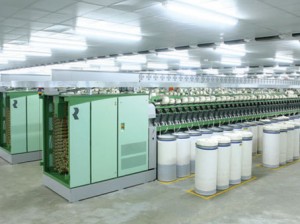 Rieter is expanding its product range with the air jet spinning machine and now offers all four spinning technologies from a single source.
Rieter is expanding its product range with the air jet spinning machine and now offers all four spinning technologies from a single source.
Each process has specific advantages. In order to simplify investment decision-making for its customers, Rieter as a systems supplier offers comprehensive, independent and objective advice covering all spinning systems.
Which is the right spinning system?
Yarn manufacturers facing an investment decision have to choose the spinning technology that is right for them. This investment decision affects their success for many years in the future. Fundamental issues need to be clarified in order to give the right answer in a specific case. Familiarity with de
differing yarn properties is one precondition for evaluating the processes.
The essential differences
In ring spinning (Fig. 1-1) and compact spinning, twist is imparted to the yarn very uniformly and precisely: both by accurately imparting twist via the spindle and due to exact nipping by the delivery roller or at the nip roller, which precisely defines the propagation of the twist that is imparted. In compact spinning, the spinning triangle is also reduced in size compared to conventional ring spinning. This results in better integration of the fibers and thus improved utilization of fiber substance. (Fig. 1-2). In both rotor spinning and air jet spinning, the fibers are twisted less consistently as viewed across the yarn cross-section. This results in lower fiber/fiber friction, reduced utilization of fiber substance and lower yarn tenacity compared to ring spinning.
In rotor spinning, accumulations of fiber occur after the yarn is released from the rotor groove, and these form so-called belly bands. Fiber integration in the fiber bundle and the belly bands produce the unique character of the yarn, which has a larger diameter than ring-spun yarn. (Fig. 1-3)
Air jet spinning produces a yarn structure that can be subdivided into two groups of fiber orientation. The orientation of fibers in the fiber core is highly parallel. The fibers on the outside are twisted very uniformly at a certain angle, similar to the structure of ring-spun yarn. (Fig. 1-4). Although these yarn structures can be influenced to a certain extent by technology elements and spinning parameters, they result in fundamentally different yarn properties – with the same raw material, yarn count and twist.
Advantages in yarn processing
The yarns can also be rated according to their advantages in downstream processing. Numerous trials have studied the effect of yarn properties on their behavior and effect in subsequent processes. The use of compact yarns and air jet reduces fiber fly in weaving and knitting operations. Their minimal hairi
ness reduces their tendency to cling compared to ring-spun yarn, and enables sizing applications to be reduced in weaving. Compact yarns can be used to produce fabrics of high density with a special fabric structure.
Suitability for certain applications
The properties of the yarns give an indication of which yarn is most suitable for which application. For example, it is undisputed that shirting fabrics which are additionally given a non-iron finish are best produced from compact yarn with high yarn tenacity. On the other hand, a clearly defined stripe of a different color in the warp (e.g. pin-stripe) can be produced not only in compact yarn, but also alternatively in air jet yarn, as long as the requirement for adequate yarn te nacity is fulfilled. Trials conducted by Rieter have shown that textile materials made from air jet yarn display the lowest pilling tendency. This makes the yarn especially suitable for knitting applications, both for T-shirts and for underwear. Elastic and non-elastic core-spun yarns can be produced on ring or compact spinning machines. Slub yarns, i.e. fancy yarns, can be produced on ring, compact and rotor spinning machines. If the yarns are to be used in the pile of velvet and cord, yarns in which the pile can be opened readily are suitable, i.e. ring-spun, compact and air jet yarns. A different yarn character also results in a different appearance of the finished product. This potential for differentiation helps the processor to position himself innovatively in the marketplace.
The importance of the raw material
The summary in Table 3 is presented in simplified form in order to illustrate relationships and is by no means exhaustive. Only the interplay between the spinning process and the raw material provides a complete picture. For example, a rotor-spun viscose yarn can display exactly the right hand and thus the required effect in the finished garment, which could not be achieved with a compact cotton yarn. Furthermore, not all raw materials are equally suitable for the 4 different spinning processes. Ring spinning and compact spinning are the most flexible processes. Virtually any raw material and the entire range of yarn counts can be spun with only a few adjustments: natural fibers, cellulosic and synthetic fibers and their blends. Rotor spinning is superior to the other spinning processes especially in processing natural fibers with a high short fiber content. Yarns can be produced very economically in relatively high quality with rotor spinning.
Şekil. 2 4 eğirme prosesi için yerleşim örnekleri
Fig. 2 Examples of layouts for the 4 spinning processes. In air jet spinning the requirements imposed on the raw material and the quality of spinning preparation are very high. Yarn count and usable fiber length are also limited in comparison to ring spinning. The feed sliver must be very clean, the short fiber content may not exceed a certain level and the fibers must display good parallelism. The better these preconditions are fulfilled, the higher the machine efficiency.
The importance of environmental factors
The following rating of environmental factors is relative and describes a tendency. If environmental factors are not optimal and constant, the result can be a decline in pro
Şekil ductivity, quality or both. Metaphorically speaking, it can be said that a Formula 1 racing car doesn’t achieve top performance in normal road traffic conditions either. The basic cleanliness of the mill, constant climatic conditions, carefully trained, reliable personnel and well organized maintenance are environmental factors contributing to optimal running behavior. However, in the case of high-performance air jet spinning the conditions must be outstanding if high productivity levels are to be achieved and assured, and consistent high quality is to be maintained at the same time.
A question of profitability
Many of the aspects discussed above give no absolutely clear answer in favor of one of the 4 spinning processes. This is why clear calculations are so important for investment decision-making. These enable manufacturing costs to be quantified accurately. However, comparisons can only be made on the basis of systems as a whole, since the process sequences of the four processes are not identical. This is where the investor can utilize the expertise of the integrated supplier. In addition to the final spinning processes Rieter can not only supply, but also ideally design complete preparation facilities. After comprehensive consulting the integrated system can be configured optimally for the customer – adapted to his needs and the market environment. How important is flexibility for the company’s sales market? How consistent are raw material supplies? How high are manufacturing costs? Is sufficient personnel available or is automation worthwhile? By answering these questions Rieter can competently support customers and clarify which spinning process is the most suitable for ensuring the customer’s success in the specific investment case.









